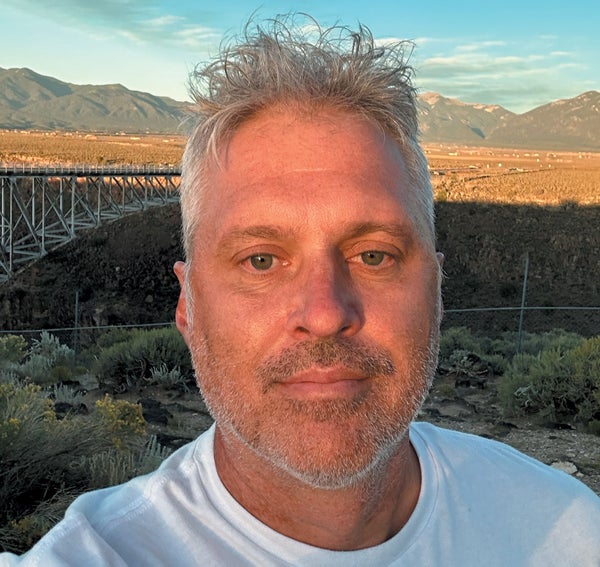
Contributors to Scientific Americans February 2025 Issue
www.scientificamerican.com
January 21, 20254 min readContributors to Scientific Americans February 2025 IssueWriters, artists, photographers and researchers share the stories behind the storiesBy Allison Parshall edited by Jen Schwartz Mark RossMark RossA New Understanding of the CellWhere Mark Ross (above) grew up in rural Connecticut, winters were often cold and dreary. When youre an artist, its good to have bad weather, he says. You just stay inside and work, and you dont feel bad about not being outside. The bucolic New England landscape inspired him to paint, and he has applied his skills to a career as an illustrator. Now based in Austin, Tex., Ross has illustrated more than a dozen Scientific American covers on topics from atmospheric storms to time crystals to nuclear fusion. For this issues cover and the articles opening art, he depicted the molecular blobs that have changed scientists understanding of cell biology. With many of the subjects he visualizes, nobody can actually see any of these things, really, he says. That gives him a lot of room for creativity when designing his captivating images.Ross loves depicting these cutting-edge scientific subjects, but he also makes time every week to practice drawing a more classical one: the human body. Its like working out, really, he says of his weekly figure painting. During these three-hour sessions, his focus narrows to depicting the person in front of him: The painting feels much more alive and immediate than if youre working from a photo.On supporting science journalismIf you're enjoying this article, consider supporting our award-winning journalism by subscribing. By purchasing a subscription you are helping to ensure the future of impactful stories about the discoveries and ideas shaping our world today.Science writer Philip Ball sees the blobs everywhere. About a decade ago he visited a laboratory in Germany where scientists had found a strange clumping mechanism in worm embryo cells. These so-called biomolecular condensates have turned out to be important for just about every aspect of cellular function. Its kind of extraordinary, Ball says. Every week it feels to me that Im looking at papers [where] theres a new kind of role for condensates.In his cover story, Ball explores how these mysterious and vital blobs are rewriting our narrative about how cells work. Traditionally the cell has been described like a machine, but Ball has suspected this was too simplistic since his days getting his Ph.D. in condensed matter physics. Hed had this feeling that theres more going on in cells than we acknowledge.After thoroughly enjoying writing his thesis (which is weird, because most people hate that, he says), Ball decided to pursue a career as a science writer and has now authored 30 books. His most recent one, How Life Works, explores this new, rich vision of biologys inner workings. I do really think we need to get away from this metaphor of the machine when were talking about the cell, he says. There is no machine we have ever built that works in the way these entities seem to.Zane WolfGraphic ScienceIn college, Zane Wolfs career plan was to say yes to everything that sounded fun. Thats how they ended up working in five labs, studying abroad in Australia and doing fieldwork in Antarctica. Wolf studied both biology and applied physics, and for their Ph.D. they married the two fields by developing soft robotic systems that mimic how fish swim. I love being guided by curiosity, digging into the data, finding out what the story isand then sharing what I learned, Wolf says.This far-reaching, restless curiosity has guided them to data visualization and a graphics internship with Scientific American. For this issues Graphic Science, written by Clara Moskowitz, Wolf charted the growth of one of humanitys coolest clubs: people who have been to space. This is one of the most exclusive groups of humans on planet Earth, they say. Wolf once dreamed of being an astronaut (as a kid, they went to space camp not once but at least three times). They designed the spread with subtle visual metaphors in mind. There are mountains, there are clouds, there are rocket-launch trails, Wolf says. Thats really fun, making the data kind of resemble the topic.Moriba JahHow to Recycle Space JunkAfter Moriba Jah enlisted in the U.S. Air Force, he was stationed in Montana guarding nuclear weapons. Thats when I got exposed to the darkest night I had ever [seen] in my life, he says. The skys just jam-packed with stars, he addsand with satellites. Routinely seeing satellites with the naked eye inspired him to become a space scientist tracking human-made objects in orbit. Then, after having a deep spiritual experience while on a trip in 2015 with his son in Denali, Alaska, he felt called to focus his research on making humans use of space sustainable. Orbital space around Earth is part of Earth, he says. Earth, land, ocean, spacetheyre all interconnected.During the past century people have treated spacelike land and oceans before itas a dumping ground. In his feature article, Jah argues for the creation of a circular space economy. Everything we launch is a single-use satellite, and its as bad as a single-use plastic, he says. When [the machines] die, they stay in orbit for many years.In the past decade this problem has escalated, he notes, and it is becoming more and more common for pieces of space junk to fall back to Earth, threatening lives. Until we get into using reusable and recyclable satellites in orbit, Jah says, were going to be facing increasingly challenging times ahead.
0 Σχόλια
·0 Μοιράστηκε
·127 Views


